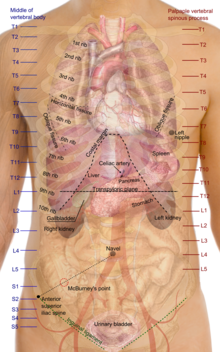
Situs solitus (from Latin 'usual site') is the medical term referring to the normal position of thoracic and abdominal organs. Anatomically, this means that the heart is on the left with the pulmonary atrium on the right and the systemic atrium on the left along with the cardiac apex. Right-sided organs are the liver, the gall bladder and a trilobed lung as well as the inferior vena cava, while left-sided organs are the stomach, single spleen, a bilobed lung, and the aorta.[1]
Variants on the normal picture are relatively uncommon. Complete reversal of all organs is known as situs inversus, while reversal of some organs but not others is called situs ambiguus or heterotaxy. Isolated reversal of the heart with normally-patterned viscera otherwise is termed dextrocardia.
- ^ Izpisúa Belmonte, JC (Jun 1999). "How the body tells left from right". Scientific American. 280 (6): 46–51. Bibcode:1999SciAm.280f..46C. doi:10.1038/scientificamerican0699-46. PMID 10349731.